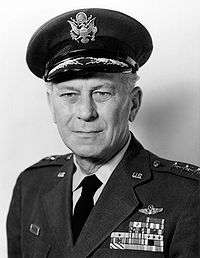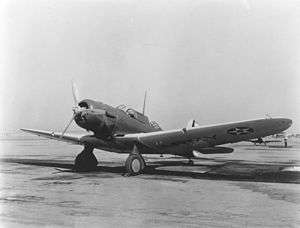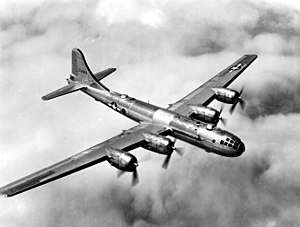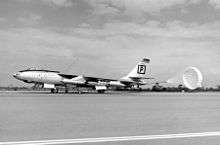Frank A. Armstrong
Frank Alton Armstrong Jr. (May 24, 1902 – August 20, 1969) was a lieutenant general of the United States Air Force. As a brigadier general in the United States Army Air Forces during World War II, he was the inspiration for the main character in the novel and subsequent film, Twelve O'Clock High. After the war, he held a variety of senior leadership positions prior to and following the establishment of the USAF as an independent service in 1947. Promoted to major general in 1950, he advanced to lieutenant general in 1956 and retired at that rank in 1962.
Frank Alton Armstrong Jr. | |
|---|---|
 Official photograph Lt. Gen. Frank Armstrong | |
| Nickname(s) | "Army" |
| Born | May 24, 1902 Hamilton, North Carolina |
| Died | August 20, 1969 (aged 67) |
| Buried | |
| Allegiance | |
| Service/ | |
| Years of service | 1928–1962 |
| Rank | |
| Commands held | |
| Battles/wars | World War II Cold War |
| Awards | |
| Spouse(s) | Vernelle Lloyd Hudson |
Armstrong commanded two B-17 Flying Fortress groups and a wing each of B-17 and B-29 Superfortresses in combat operations against both Germany and Japan. He personally led the first USAAF strategic bombing attack from England in August 1942, and the last strategic raid on Japan three years later. He also led the first attack by the USAAF against a target in Germany.
Early life
Armstrong was born in Hamilton, North Carolina.[1] He played minor league professional baseball from 1925 to 1928, after he graduated from Wake Forest College with a law degree in 1923 and a bachelor of science degree in 1925.[1]
Military career
Air Corps
He enlisted as a flying cadet in the Army Air Corps on February 24, 1928,[1] and received his flight training at Brooks Field and Kelly Field, San Antonio, Texas. He received his wings and reserve officer's commission on February 28, 1929, and his commission in the Regular Army on May 2, 1929. His first assignment was to the 2nd Bombardment Group at Langley Field, Virginia, where he married Vernelle Lloyd Hudson on March 15, 1929.[1] His son, Frank Alton Armstrong III, was born March 7, 1930. Armstrong was made a flight instructor at March Field, Riverside, California, in 1930, and at Randolph Field, San Antonio, Texas, in 1931.
In March 1934, he was one of a group of Army pilots placed under the command of Captain Ira Eaker. On October 1, 1934, he was promoted to 1st lieutenant. Armstrong was assigned in December 1934 as a pursuit pilot at Albrook Field, Panama Canal Zone. In 1937, Armstrong earned the Distinguished Flying Cross in peacetime by skillfully landing an amphibian airplane whose engine had exploded. He was promoted to the temporary rank of captain on March 15, 1936, returned to his permanent pay grade on June 16, and was made a permanent captain on May 2, 1939.

In March 1937, Armstrong transferred to the 13th Attack Squadron, Barksdale Field, Louisiana, part of the 3rd Attack Group, flying Northrop A-17 attack planes. He became its commander on May 7, 1939, and continued in command of the squadron on July 1, 1939, when it became the 13th Bombardment Squadron (Light), converting to B-18 Bolo bombers. Armstrong commanded the 13th BS until October 5, 1940. Between September 6, 1939, and October 2, 1940, he temporarily relinquished command to attend the second "short course" at the Air Corps Tactical School at Maxwell Field, Alabama.
From November 1940 to February 1941, Armstrong was a combat observer with the Royal Air Force in England, then returned to command the 90th Bombardment Squadron, Savannah AAF, Georgia, promoted to major on March 15 and lieutenant colonel on January 5, 1942. Armstrong was the Assistant Chief of Air Staff, A-3 (Operations) at Army Air Forces headquarters in Washington, D.C. when he was selected on January 24, 1942, to accompany Eaker, now a general, to England with five other officers to establish the VIII Bomber Command, Eighth Air Force, where he became its operations officer (A-3) and was promoted to colonel on March 1, 1942.
Combat group commander

As a "trouble-shooter" for Eaker, on July 31, 1942, Armstrong relieved Colonel Cornelius W. "Connie" Cousland of command of the inadequately-trained 97th Bomb Group, the first group of B-17 Flying Fortress bombers sent to England, and put it through an intensive training period at RAF Polebrook. He then led it in combat on six of its first 10 missions from August 17 to September 2, 1942. Armstrong led the first daylight heavy bomber raid made by the USAAF over Occupied Europe, receiving the Silver Star and an oak leaf cluster to the Distinguished Flying Cross. He was also awarded the British Distinguished Flying Cross for the initial mission, the first U.S. officer to be so honored. Because he had not yet been checked out as a combat pilot in the B-17, Armstrong flew the first mission as the co-pilot of a Fortress piloted by Major Paul W. Tibbets, one of his squadron commanders.
Armstrong returned to the staff of Bomber Command until January, 1943, when Eaker again used him to rebuild another bomb group performing below standards. From January 4 to February 17, 1943, Armstrong commanded the 306th Bomb Group at RAF Thurleigh, England, and led the first mission by the Eighth Air Force to bomb Nazi Germany. His experiences with the 97th and 306th groups became the basis of Sy Bartlett and Beirne Lay Jr.'s novel and film Twelve O'Clock High. While in command of the 306th, Armstrong led the Eighth Air Force on its first mission to attack a target in Germany on January 27, 1943.
Biographers have noted that Armstrong was superstitious about flying. He always entered the B-17 by its rear fuselage door rather than through the nose hatch as most pilots did, and he always carried a pair of his son's baby shoes on all flights, for good luck in combat.
Wing commands
On February 8, 1943, Armstrong was promoted to brigadier general, and then assigned command of the newly formed 101st Provisional Combat Wing on February 17, continuing to fly combat missions over Germany. On June 16, 1943, Armstrong was advanced to command of the 1st Bombardment Wing, replacing daylight precision bombardment theorist Haywood S. Hansell, and was himself replaced at the end of July 1943 after being injured in a fire in his quarters.
During his final combat mission in the European Theater of Operations on April 5, 1943, 104 B-17s and B-24s attacked the Erla Works, used by the Luftwaffe for manufacturing and reconditioning Me-109 fighters, near the Antwerp suburb of Mortsel. The attack caused widespread casualties in the town when the force was subjected to severe air attack during its bombing run and only four bombs hit their intended target. In just eight minutes 936 people were killed, including 209 children under the age of 15 when four schools received direct hits. It was Belgium's worst loss of life in a single incident during the entire war.

Armstrong returned to the United States where he commanded the 46th Bombardment Operational Training Wing (B-17) at Ardmore Army Airfield, Oklahoma (September 10, 1943 to April 6, 1944); and the 17th Bombardment Operational Training Wing (B-29) at Peterson Field, Colorado, and Grand Island Army Airfield, Nebraska (April 7, 1944, to November 7, 1944). When the Manhattan Project was still in its development stage, Armstrong was the leading candidate (along with Colonel Roscoe C. Wilson, the Army Air Force officer providing liaison support to the project) to command the unit designated to drop the atomic bomb. Armstrong's age and his injury in England mitigated against his selection, however, which went to Tibbets instead.
On November 18, 1944, Armstrong was given command of the 315th Bomb Wing at Peterson Field, Colorado, a B-29 Superfortress wing then in training. Between March 7, 1945, and April 5, 1945, the wing deployed to Northwest Field, Guam on to fly missions against the Home Islands of Japan. On August 15, 1945, Armstrong led the longest and final heavy bombing raid in the war, with the distinction of having led both the first and last USAAF strategic bombing missions of World War II, as well as the first USAAF mission to attack Germany. In November 1945, he flew the first non-stop flight from Japan to Washington, D.C. in a B-29. He received an oak leaf cluster to the Distinguished Flying Cross for each of the above achievements.
USAF service
Armstrong continued his Air Force career following World War II, first becoming chief of staff for operations of the Pacific Air Command on January 18, 1946, and then senior air advisor at the Armed Forces Staff College, Norfolk, Virginia, on September 9, 1946. After creation of the United States Air Force, Armstrong served as deputy commanding general of the Alaskan Air Command at Fort Richardson, Alaska (March 31, 1948), and its commanding general (February 26, 1949, to December 26, 1950). While commander, he was awarded the Gold Medal of the Aero Club of Norway, the highest civil award of Norway, for helping develop a non-stop polar air route from Alaska to Norway to New York.[1]

On January 13, 1950, Armstrong was promoted to major general and named base commander of Sampson Air Force Base, New York, in January 1951. On May 13, 1951, he became commanding general of the Sixth Air Division, training the first B-47 Stratojet Wing at MacDill Air Force Base, Florida, and in 1952, commander of the Second Air Force of the Strategic Air Command at Barksdale Air Force Base, Louisiana, a post he held for four years. His final posting was in July 1956, again as head of the Alaskan Air Command, and upon his promotion to lieutenant general, as commander of the joint Alaskan Command. He retired July 31, 1962.
Armstrong's son, Major Frank A. Armstrong III, USAF, followed him into the Air Force as a pilot and was killed in action in Laos on October 6, 1967. At the time, he was flying a combat mission in an A-1E Skyraider as a member of the 1st Air Commando Squadron.[2]
Awards and decorations
Source: USAF Historical Study 91: Biographical Data on Air Force General Officers, 1917-1952, Vol. I, "A-K"

| Distinguished Service Cross | |
| Distinguished Service Medal (with one oak leaf cluster) | |
| Silver Star | |
| Distinguished Flying Cross (with four oak leaf clusters) | |
| Air Medal (with oak leaf cluster) | |
| American Defense Service Medal with battle star |
| Asiatic-Pacific Campaign Medal with 3 battle stars | |
| European-African-Middle Eastern Campaign Medal with battle star |
![]()
![]()
![]()
![]()
Legacy
His papers (including correspondence, memoirs, reports, flight records, flight log, and speeches) were donated to the East Carolina Manuscript Collection in Joyner Library at East Carolina University.[3][3]
References
- Who Was Who in American History - the Military. Chicago: Marquis Who's Who. 1975. p. 15. ISBN 0837932017.
- "Bio, Armstrong, Frank A. III".
- "Collection Guides at East Carolina University".
Bibliography
- Freeman, Roger A. The Mighty Eighth (1993 edition), (pp. 67–69). ISBN 0-87938-638-X
- Freeman, Roger A. The Mighty Eighth War Diary (1990), (pp. 89–95). ISBN 0-87938-495-6
External links
- USAF official biography
- Arlington National Cemetery bio Note that official biography has error in date of death; grave marker with correct date pictured.
| Wikimedia Commons has media related to Frank A. Armstrong. |